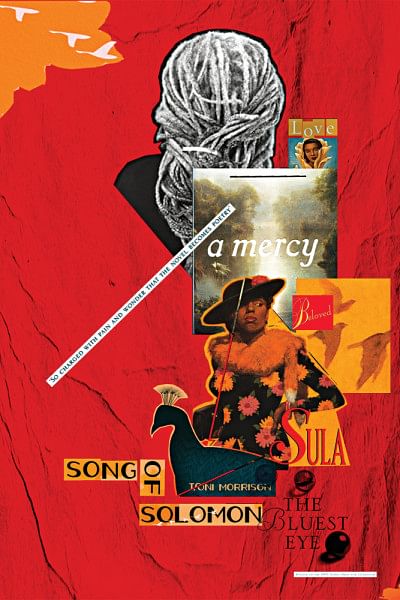Toni Morrison, author of many voices

When I think of Toni Morrison's oeuvre, the word 'geod' comes to mind. A composite whole—each novel, each essay tightly knitted, contained by the solidity and confidence of its author's direction of ideas. You think you know what to expect, given the ubiquity of its cultural influence. But split it open, delve into the pages, and you're stunned by the polyphonic insides. Her stories and nonfiction are populated by voices, memories, by colliding experiences, all of which reveal a sparkling, thriving, labyrinthine world. Morrison devoted the five decades of her writing life into ensuring that this depiction was that of the black experience, complete with its pains and joys, its unique struggles and personalities.
Chloe Anthony Wofford (or Toni as we know her) was part of a household shaped by the socio-economic implications of racism in America, and one that cultivated a love of black literature, music, and folklore. Both sets of her grandparents had had to flee sharecropping in Alabama and violence against African Americans in the south respectively, before settling in the steel-mill town of Lorain in Ohio. Born in 1931, Toni grew up at a time when the 1930s' Great Depression would have been especially taxing on a black, working class family. Her father George Wofford, a welder among two other jobs, was strongly distrustful of whites. Her mother Ramah Willis Wofford, who worked as a domestic worker, was slightly more hopeful of seeing race relations change in the country. Toni and her siblings were encouraged as children to internalise and get creative with these realities, listening to stories, remembering stories, even telling, changing, and performing them at home: "...to make us, and the race, confront the terrible things that were happening, to know that you could protect yourself through cunning and wit, by strength," she told the Denver Post in a 2003 interview.

Doing justice to the black experience through language became Toni's primary project. She did the job magnificently not because she simply wrote about African American characters, but because of the way she went about it.
Her fiction doesn't tell stories of black lives. It exists as a space in which black characters live out their experiences in real time, even as they repress and recollect past trauma. The stage time allowed to each of her characters is perhaps the most noticeable and admirable quality of Toni Morrison's work.
Take Beloved (1987), a novel about a tiny black life forced to end even before it has finished crawling and learned to walk. Beloved's existence is short-lived because it is innately 'raced', because generations of the child's ancestors have known only captivity under the white race, and because her mother Sethe, having just tasted freedom, would rather split the toddler's throat open than allow her back into slavery. The novel is populated, densely, by voices. Its structure forces us to spend time with each of them, so that we know how each person involved perceives a particular incident. Remember Sethe, her husband Halle, and Paul D who would later become her lover, all slaves at the Sweet Home plantation. If here a paragraph shows Sethe hurting, raging because Paul D didn't charge Halle enough for his passivity while Sethe was being tortured, there another chapter steps inside Paul D's mind. It reveals exactly why he remains silent, consumed by the pain of being gagged with the 'iron bit' in his mouth.
Morrison reveals these sufferings through echoes and memory and seldom through dialogue. It's neither a case of miscommunication in the plot, nor a crude ploy by the text to generate mystery and agitation for the reader's entertainment. It's about showing how words simply fail at describing certain experiences. Discussing this scene with Paul D in her famous "The Art of Fiction" interview with The Paris Review, she explained how, "It was important to imagine the 'bit' as an active instrument, rather than simply as a curio or an historical fact. I wanted to show the reader what slavery felt like, rather than how it looked." As readers, as a result, we all but drown in the characters' personal journeys—be it Denver, Sethe, Paul D, or Baby Suggs—but we're snatched back just in time to remember that the story is ultimately Beloved's.
Their agonies may ring loud and true (as they should), but it is the pain of the most voiceless, the one most abruptly silenced, that Morrison manifests into an entire novel. She names the very book after her.
Speaking to the Guardian, Morrison once acknowledged how she couldn't tap into standard recorded 'history' to contextualise these stories. It would be ridiculous for her to look to Lewis Mumford or Thomas Jefferson's version of American history, or to Hemingway, Conrad, or Melville's portrayals of it even when they wrote about black characters.
"There is no reliable literary or journalistic or scholarly history available to [black lives], to help them, because they are living in a society and a system in which the conquerors write the narrative of their lives," she explained. "First was my effort to substitute and rely on memory rather than history because I knew I could not, should not, trust recorded history to give me the insight into the cultural specificity I wanted. There was and is another source that I have at my disposal, however: my own literary heritage of slave narratives." On a somewhat similar vein, to The Paris Review, she addressed how, "In American literature we have been so totalised—as though there is only one version. We are not one indistinguishable block of people who always behave the same way."
And so her project became one of not just depicting, but de-totalising history, of unpinning it from a white-washed, male dominated narrative and bringing it down to the personal, the specific, the uniquely remembered. In her debut novel The Bluest Eye (1970), we experience the young Pecola struggling with her African American features, longing for blonde hair, fair skin, and blue eyes. What are the implications of such a desire? Sula (1973) pushes the premise of 'evil'—which Toni believed is perceived somewhat differently by African Americans ("They don't destroy it or throw it out of the house.")—to the centre of a novel that explores the contrasting experiences of stability and the lack thereof in black lives. Song of Solomon (1977) bottles in the journey of a single character—Milkman Dead—a saga of American history, infusing its ties with fantasy, folklore, music, and family roots. In her sixth novel Jazz (1992), Morrison takes us into 1926 Harlem, ringing with the cacophony of black urban lives.

These and her other works hardly ever aim for a clinical and 'objective' portrayal of events; instead, Toni's stories are richly coloured by the anger, resignation, and wonder felt by its inhabitants. The colours shine through in her nonfiction as much as in her 11 novels and handful of short stories. In her article "What the Black Woman Thinks About Women's Lib" for The Times written in 1971, she parses through a permutation of opinions regarding race and autonomy between black men, white men, black women, and white women. Both black and white men have historically dominated their female counterparts, but the black man's dominion over black women is also touched by a need to vent his pent-up rage. The black woman, unlike her white counterpart, has also historically known how to retaliate, because of the relative autonomy she possesses from having a place in the job market. The black woman also can't afford to exist simply as a sexual object even if the men around her cast her in that role, because she has had to be so many other things. "In a way black women have known something of the freedom white women are now beginning to crave. But oddly, freedom is only sweet when it is won. When it is forced, it is called responsibility. White women, on the other hand, have had too little responsibility, white men too much. It's a wonder the sexes of either race even speak to each other," she wrote.
Fascination with literature drove Toni Morrison through high school, through her undergraduate and Master's degrees in English from Howard and Cornell universities respectively. It bore her through an editorship at Random House, her teaching tenure at Princeton, and the many awards she earned, the most prestigious of which were the Pulitzer Prize in Fiction 1988 and the Nobel Prize in Literature 1993. But as she asserted time and again in interviews, Toni was, above all, a reader. She basked completely and entirely in the joy of reading, in the way a text can generate joy and ideas and resolve and empathy if one only knows how to play with language the right way. Her own words are proof of that, push and prod as they do the traditional boundaries of the English language. She has always twisted words to tweak their meanings— "memory" to "rememory", "rememory" to "re-remember" — and, by extension, our emotional and ideological responses to story and history. She economised with images and description, ensuring that we would imagine and feel, instead of simply watching as a bystander. And with simple jumps in punctuation, she tempered her sentences to radiate nostalgia and anger and affection all in the same paragraph. Reading her, you recognise both a woman of fierce strength and courage, and a human being who believed utterly in storytelling as a vehicle of power and agency. The right kind of agency. In her absence, the words she left behind keep her project alive.
The writer can be reached at [email protected].

 For all latest news, follow The Daily Star's Google News channel.
For all latest news, follow The Daily Star's Google News channel. 



Comments